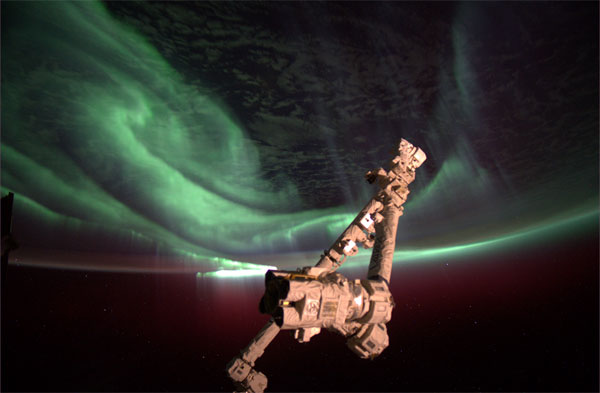Amazing Southern Lights View from Space Leaves Astronaut Awestruck

Shimmering auroras in the night sky are amazing to behold, but nothing prepared one NASA astronaut for seeing the celestial lights dance over Earth from above.
A new photo of the southern lights by astronaut Joe Acaba convey only a portion of the amazing view from his window on the International Space Station during a weekend photo session to catch the auroras over Earth. Acaba watched the auroras on Saturday and Sunday (July 14 and 15) from the station's observation deck, a seven-window cupola that offers astronauts a 360-degree of space and the Earth below.
On Saturday, Acaba took a break from a workout session to gaze down at Earth as the space station made a southern night pass. With a recent uptick in the sun's activity, including a major solar flare last week, he was hopeful to see at least some auroras.
"Within a couple of minutes, I could not believe what I was seeing. It was absolutely incredible," Acaba wrote in a journal post Sunday. "I enjoyed the show for a few minutes and then felt I had to inform my crew mates so they could also take in the view." [More Auroras Photos from July Solar Storm]
At the time, the space station was home to three people: Acaba and two cosmonauts. Even the space station's veteran commander, cosmonaut Gennady Padalka now on his third tour in charge of the outpost, was amazed, Acaba explained.
"I am no expert with a camera but I tried to capture at least a small reminder of the experience. The pictures were not great, but they would do," Acaba wrote.
Auroras are caused when charged particles from the sun interact with the Earth's upper atmosphere to create a bright glow. Because the activity is concentrated over Earth's poles, they are known as the aurora borealis (northern lights) in the north, and the aurora australis (southern lights) in the south.
Get the Space.com Newsletter
Breaking space news, the latest updates on rocket launches, skywatching events and more!
Acaba's Saturday aurora show set stage for Sunday, when an intense solar storm from a July 12 solar flare supercharged Earth's auroras.
"So today, at around the same time of day, I thought I would take one more look," Acaba wrote Sunday. "Just when you think it can’t get much better, it gets way better."
And there are times, Acaba added, when you just have to set the camera aside and soak in the view.
"I of course took some obligatory pictures, but then I just sat in the dark, in the peace and quiet of this incredible man made, orbiting laboratory and just looked out the window in awe," he added. "That a truly magnificent planet we live on and solar system we live in."
Acaba is one of six residents of the space station today. Three new crewmembers arrived at the orbiting lab early Tuesday (July 17). Acaba, Padalka and cosmonaut Sergei Revin have been living aboard the station since mid-May and are due to return to Earth in September.
Editor's note: If you snap any amazing photos of the northern or southern lights that you'd like to share for a story or gallery, please send images and comments to SPACE.com managing editor Tariq Malik at tmalik@space.com.
You can follow SPACE.com Managing Editor Tariq Malik on Twitter @tariqjmalik. Follow SPACE.com on Twitter @Spacedotcom. We're also on Facebook and Google+.
Join our Space Forums to keep talking space on the latest missions, night sky and more! And if you have a news tip, correction or comment, let us know at: community@space.com.

Tariq is the Editor-in-Chief of Space.com and joined the team in 2001, first as an intern and staff writer, and later as an editor. He covers human spaceflight, exploration and space science, as well as skywatching and entertainment. He became Space.com's Managing Editor in 2009 and Editor-in-Chief in 2019. Before joining Space.com, Tariq was a staff reporter for The Los Angeles Times covering education and city beats in La Habra, Fullerton and Huntington Beach. In October 2022, Tariq received the Harry Kolcum Award for excellence in space reporting from the National Space Club Florida Committee. He is also an Eagle Scout (yes, he has the Space Exploration merit badge) and went to Space Camp four times as a kid and a fifth time as an adult. He has journalism degrees from the University of Southern California and New York University. You can find Tariq at Space.com and as the co-host to the This Week In Space podcast with space historian Rod Pyle on the TWiT network. To see his latest project, you can follow Tariq on Twitter @tariqjmalik.









